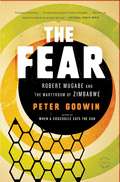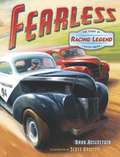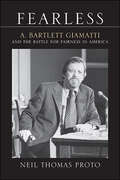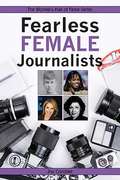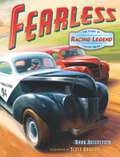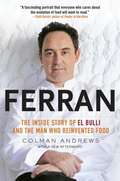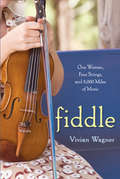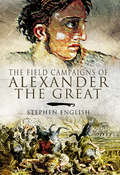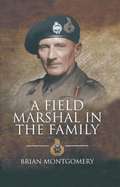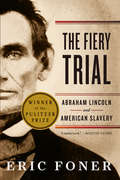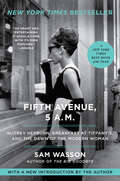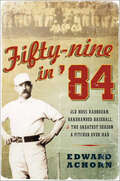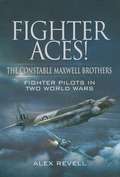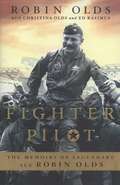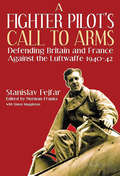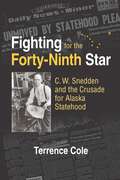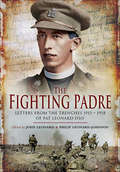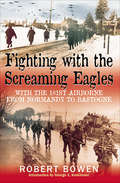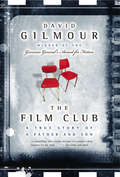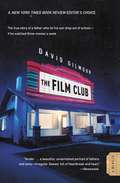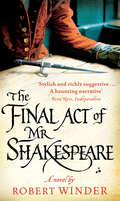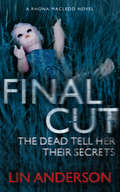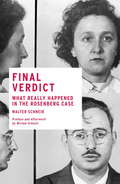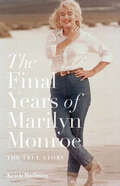- Table View
- List View
The Fear: Robert Mugabe and the Martyrdom of Zimbabwe
by Peter GodwinJournalist Peter Godwin has covered wars. As a soldier, he's fought them. But nothing prepared him for the surreal mix of desperation and hope he encountered when he returned to Zimbabwe, his broken homeland. Godwin arrived as Robert Mugabe, the country's dictator for 30 years, has finally lost an election. Mugabe's tenure has left Zimbabwe with the world's highest rate of inflation and the shortest life span. Instead of conceding power, Mugabe launched a brutal campaign of terror against his own citizens. With foreign correspondents banned, and he himself there illegally, Godwin was one of the few observers to bear witness to this period the locals call The Fear. He saw torture bases and the burning villages but was most awed as an observer of not only simple acts of kindness but also churchmen and diplomats putting their own lives on the line to try to stop the carnage.THE FEAR is a book about the astonishing courage and resilience of a people, armed with nothing but a desire to be free, who challenged a violent dictatorship. It is also the deeply personal and ultimately uplifting story of a man trying to make sense of the country he can't recognize as home.
Fearless: The Story Of Racing Legend Louise Smith
by Barb Rosenstock Scott DawsonWhen Louise Smith started racing cars, most girls weren't even allowed to drive. From her first wild adventure behind the wheel of her daddy's Ford to the dangers and thrills of stock-car tracks across the country, Louise fearlessly paved the way for women in racing and became a NASCAR legend! It takes a lot of courage to be the first, but when you fearlessly follow your dreams, anything is possible.
Fearless: A. Bartlett Giamatti and the Battle for Fairness in America (Excelsior Editions)
by Neil Thomas ProtoFinalist for the 2021 The Next Generation Indie Book Award in the Autobiography/Biography Category presented by the Independent Book Publishing Professionals Group Bronze Winner, 2020 Foreword INDIES Book of the Year Award in the Biography Category In 1977, a thirty-nine-year-old Italian American professor of Renaissance literature, A. Bartlett Giamatti, was chosen as the next president of Yale University, a radical act that was immediately perceived as a threat to the university's embedded, eugenics-driven, Anglo-Saxon mentality. Eugenics, as practiced in America, and especially at Yale, locked into place those who were deemed "unfit" due to beliefs about their ethnicity, class, and racial character, beliefs that had endured for decades and to which Giamatti's selection, as an Italian American and therefore, to some, one of the "unfit," was an open rebuke.In Fearless, Neil Thomas Proto explores the origins of Giamatti's ethical convictions, including his insistence on fairness, his respect for the duty of responsible citizenship, and his advocacy for people on the margins. Proto argues that these convictions, which would inform Giamatti's time at Yale as well as his brief tenure as commissioner of Major League Baseball, can be understood only in the context of Giamatti's family and the deeply entwined and conflicted histories of Yale and New Haven itself—a history that Giamatti, who had been both a student and a professor at Yale and who had Italian American relatives in New Haven, knew very well.Historian Sean Wilentz wrote that "Bart Giamatti was a phenomenon who lived the lives of several men even though his own ended tragically early." Giamatti confirmed his underlying imperative through to the end of his life: "Rest," he wrote, "will come by never resting." Fearless is a story about persistence against forces ugly, embedded, and more pernicious than simply racial and ethnic discrimination, and about the principled embrace of civic duty passed on generationally and used fully as the ethical sword and shield necessary to challenge them.
Fearless Female Journalists
by Joy CrysdaleThis book tells the inspiring stories of ten women, in all types of journalism, who put themselves at risk to do their jobs. Put all together, their lives also tell the story of journalism itself, its importance to society and the struggle that the women in this field have gone through to do the work that they love and to provide an essential service to society. In an age when many young people's experience of journalism is limited to celebrity gossip and sports scores, Fearless Female Journalists demonstrates the essential role that these women have played, by telling the stories of just a few of those who are willing to stand up to ridicule, make personal sacrifices and even, in some cases, lose their lives to tell the stories that need to be told.
Fearless: The Story of Racing Legend Louise Smith
by Barb RosenstockWhen Louise Smith started racing cars, most girls weren't even allowed to drive. From her first wild adventure behind the wheel of her daddy's Ford to the dangers and thrills of stock-car tracks across the country, Louise fearlessly paved the way for women in racing and became a NASCAR legend!It takes a lot of courage to be the first, but when you fearlessly follow your dreams, anything is possible.
Ferran: The Inside Story of El Bulli and The Man Who Reinvented Food
by Colman AndrewsMore than just the most influential chef of the late- twentieth and early-twenty-first centuries, Ferran Adrià is arguably the greatest culinary revolutionary of our time. Hailed as a genius and a prophet by fellow chefs, worshipped (if often misunderstood) by critics and lay diners alike, Adrià is imitated and paid homage to in professional kitchens, and in more than a few private ones, all over the world. A reservation at his restaurant, El Bulli, is so coveted that scoring a table is harder than nabbing fifty-yard-line tickets for the Super Bowl. In his lively, and unprecedented, close-up portrait of Adrià, award-winning food writer Colman Andrews traces this groundbreaking chef's rise from resort hotel dishwasher to culinary deity, and the evolution of El Bulli from a German-owned beach bar into the establishment voted annually by an international jury to be "the world's best restaurant. " Taking the listener from Adrià's Franco-era childhood near Barcelona through El Bulli's wildly creative "disco-beach" days and into the modern-day wonderland of Adrià's restaurant kitchen and the workshop/laboratory where his innovations are born and refined, Andrews blends sweeping storytelling with culinary history to explore Adrià's extraordinary contributions to the way we eat. Through original techniques like deconstruction, spherification, and the creation of culinary foams and airs, Adrià has profoundly reimagined the basic characteristics of food's forms, while celebrating and intensifying the natural flavors of his raw materials. Yet, argues Andrews, these innovations may not be his most impressive achievements. Instead, Adrià's sheer creativity and courageous imagination are his true genius-a genius that transcends the chef's métier and can inspire and enlighten all of us. Early in 2010, Ferran stunned the food world by announcing that he plans to close El Bulli at the end of the 2011 season for a two-year hiatus. Chefs, critics, and food-lovers everywhere are asking what that means for this legendary chef and his groundbreaking restaurant. Andrews reveals the inside story, from Ferran himself. Entertaining and intimate, Ferran brings to life the most exciting food movement of our time and illuminates the ways in which Adrià has changed our world-forever altering our understanding of and appreciation for food and cooking.
Fiddle
by Vivian WagnerFiddling suddenly seemed vitally important, even necessary, for me to learn. Perhaps it had to do with grief for my mom's death, and with the fact that I was just starting to feel the inklings of a midlife crisis coming on. All I knew consciously, though, was that I had to learn it.After a chance encounter with fiddle music, Vivian Wagner discovered something she never knew she had lacked. The fiddle had reawakened not only her passion for music, but for life itself. From the remote workshop of a wizened master fiddle maker in the Blue Ridge Mountains to a klezmer band in Cleveland, from Cajun fiddle music in Katrina-ravaged New Orleans to a fiddle camp in Tennessee, Vivian's quest to master the instrument becomes a journey populated by teachers and artisans--and ultimately creates a community that fortifies her through an emotionally crushing loss. Intimate and enlightening, this is a story about the unique gifts of the fiddle, the redeeming power of music, the freedom of improvisation--and the importance of knowing that even though a song may reach its end, there's always a new tune to learn. . ."Charming, smart, lyrical and surprising. I recommend it to anyone--savage beast or not--who needs their soul soothed." --Suzanne Finnamore, international bestselling author of Split
The Field Campaigns of Alexander the Great
by Stephen EnglishAlexander the Great is one of the most famous men in history, and many believe he was the greatest military genius of all time (Julius Caesar wept at the feet of his statue in envy of his achievements). Most of his thirteen year reign as king of Macedon was spent in hard campaigning which conquered half the then-known world, during which he never lost a battle. Besides the famous set-piece battles (Granicus, Issus, Gaugamela, Hydaspes), Alexander's army marched thousands of miles through hostile territory, fighting countless smaller actions and calling for a titanic logistical effort.There is a copious literature on Alexander the Great, but most are biographies of the man himself, with relatively few recent works analyzing his campaigns from a purely military angle. This book will combine a narrative of the course of each of Alexander's campaigns, with clear analysis of strategy, tactics, logistics etc. This will combine with Stephen English's The Army of Alexander the Great and The Sieges of Alexander the Great, to form a very strong three-volume examination of one of the most successful armies and greatest conquerors ever known.
A Field Marshal in the Family
by Brian MontgomeryField Marshal Viscount Montgomery of Alamein has attracted the attention of countless historians over the last 70 years but, despite this coverage, views of his character remain controversial and contradictory. His younger brother Brian, himself a successful soldier, enters the fray with this charming and revealing book examining the background of this legendary military commander. He provides a fascinating account of the influences of Montys family genes together with a wealth of unknown details about his career. His grandfather, Sir Robert Montgomery, played a key role in crushing the Indian Mutiny and his adventures have intriguing parallels with those of Montys two generations later. Dean Farrar, his maternal grandfather, was a powerful Victorian educational and religious figure (Headmaster of Marlborough College and Dean of Canterbury) and author of the iconic Eric, or Little by Little.The author examines in the most entertaining and frank manner Montys idiosyncratic character traits; his opposition to tradition, his Nelsonian approach to rules and regulations, his ruthlessness and determination and his unfashionable views on the absolute necessity for self publicity and the most intensive training to get the maximum from his subordinates, down to the most junior levels.
The Fiery Trial: Abraham Lincoln and American Slavery
by Eric Foner"A masterwork [by] the preeminent historian of the Civil War era."--Boston Globe Selected as a Notable Book of the Year by the New York Times Book Review, this landmark work gives us a definitive account of Lincoln's lifelong engagement with the nation's critical issue: American slavery. A master historian, Eric Foner draws Lincoln and the broader history of the period into perfect balance. We see Lincoln, a pragmatic politician grounded in principle, deftly navigating the dynamic politics of antislavery, secession, and civil war. Lincoln's greatness emerges from his capacity for moral and political growth.<P><P> Pulitzer Prize Winner
Fifth Avenue, 5 A.M.: Audrey Hepburn, Breakfast at Tiffany's, and the Dawn of the Modern Woman
by Sam WassonNow in paperback in time for the 60th anniversary of the film version Breakfast at Tiffany’s— the New York Times bestseller and first-ever complete account of Audrey Hepburn and the making of the film that Janet Maslin called “a bonbon of a book filled with delightful anecdotes”With a cast of characters that includes Audrey Hepburn, Truman Capote, and Gerald Clarke, this book offers a slice of social history seen through the lens of one of America’s most iconic films The images of Breakfast at Tiffany’s are branded into our collective memory: we can see Audrey Hepburn stepping out of that cab on the corner of 57th and 5th, and we can picture her again with George Peppard, huddled in an alleyway and wrapped in a kiss, as the rain pours down around them. Those moments are as familiar to us as any in whole the history of movies, but few of us know that that ending was not the film’s original ending. In fact, it was only one of two endings the filmmakers shot—and it almost didn’t make it in. The reasons why have to do with Tiffany’s cutting-edge take on sex in the city, namely, when to show it, and how to do it, without getting caught. If Truman Capote had it his way, his beloved Marilyn Monroe would have been cast as Holly, but crafty executives knew that she’d have the censors on red alert. So they went for Audrey. But would she go for them? Frightened at the prospect of playing a part so far beyond her accepted range—not to mention the part of call girl—Audrey turned inside out worrying if she should take her agent’s advice and accept the role. What would people think? America’s princess playing a New York bad girl? It seemed just too far…The First Little Black Dress is the first ever complete account of the making of Breakfast at Tiffany’s. Drawing upon countless interviews with those involved in the film’s production, from actors to producer Richard Shepherd to Gerald Clarke, Capote’s biographer, Wasson brings us inside the world and indeed inside the mind of one of America’s greatest cinematic icons.Wasson immerses us in the America of the late fifties, before Woodstock and birth control, when a not-so-virginal girl by the name of Holly Golightly raised eyebrows across the nation, changing fashion, film, and sex, for good. But that was the easy part. Getting Audrey there—and getting the right people behind her—that was the tough part.With the heart of a novelist and the eye of a critic, Wasson delivers us from the penthouses of the Upper East Side to the pools of Beverly Hills, from script to screen and from rehearsal to “Action!” The First Little Black Dress presents Breakfast at Tiffany’s as we have never seen it before—through the eyes of those who made it.
Fifty-Nine in '84: Old Hoss Radbourn, Barehanded Baseball, & the Greatest Season a Pitcher Ever Had
by Edward Achorn"First-class narrative history that can stand with everything Steven Ambrose wrote. . . . Achorn's description of the utter insanity that was barehanded baseball is vivid and alive." —Boston Globe“A beautifully written, meticulously researched story about a bygone baseball era that even die-hard fans will find foreign, and about a pitcher who might have been the greatest of all time.” — Joseph J. Ellis, Pulitzer prize-winning historianIn 1884 Providence Grays pitcher Charles "Old Hoss" Radbourn won an astounding fifty-nine games—more than anyone in major-league history ever had before, or has since. He then went on to win all three games of baseball's first World Series.Fifty-nine in '84 tells the dramatic story not only of that amazing feat of grit but also of big-league baseball two decades after the Civil War—a brutal, bloody sport played barehanded, the profession of uneducated, hard-drinking men who thought little of cheating outrageously or maiming an opponent to win.Wonderfully entertaining, Fifty-nine in '84 is an indelible portrait of a legendary player and a fascinating, little-known era of the national pastime.
Fighter Aces!: The Constable Maxwell Brothers: Fighter Pilots in Two World Wars
by Alex RevellWhen Gerald Constable Maxwell was flying as a fighter pilot in World War I, his brother Michael was born. Both went on to have distinguished flying careers in World War II. This is the story of both men and how their paths crossed during the second conflict.Gerald served with distinction with 56 Squadron, one of the crack fighter units of WWI in France. Upon his return to England he became Chief Flying Instructor of No. 1 Fighter and Gunnery School at Turnberry. In World War II he served as Station Commander at RAF Ford, a night Fighter station near Arundel, one of the most efficient and happy stations in 11 Group.Michael followed in his brothers footsteps and joined 56 Squadron in April 1940 to fly the Hawker Hurricane. During May the squadron was moved to France to assist the fast retreating British and French forces as the Germans rapidly advanced. On 27 May, he was shot down whilst attacking ten Heinkel 111s on their way to bomb Dunkirk. Fortunately his first contacts upon landing by parachute were French and he managed to find his way to Ostend where he boarded a trawler and crossed the Channel back to Deal.56 Squadron had by now returned to their English base at North Weald from where they were flying patrols over the French coast and escorting RAF bombers raiding the German positions. On 8 June, whilst trying to reach returning Blenheims over Le Treport, the Hurricanes were bounced by Bf 109s and again Michael was hit, wounding him in the leg and foot, fortunately he eventually managed a crash landing back at North Weald. During the height of the Battle of Britain Michael was again forced to make a crash landing near Herne Bay which he was lucky to survive as his Hurricane had disintegrated around him.In the autumn of 1941 Michael was posted to 604 Nightfighter Squadron, led by the legendary Cats Eyes Cunningham flying Beaufighters and eventually Mosquitos. He was eventually to Command the squadron whose tally of enemy aircraft shot down when he left it had reached 100. This remarkable story includes first-hand combat accounts from both Michael and Gerald and the author has had access to the Constable Maxwells family records.
Fighter Pilot: The Memoirs of Legendary Ace Robin Olds
by Robin Olds Christina Olds Ed RasimusThe biography of American fighter pilot Robin Olds, who was a larger-than-life hero with a towering personality.
A Fighter Pilot's Call to Arms: Defending Britain and France Against the Luftwaffe, 1940–1942
by Simon Muggleton Stanislav FejfarThe World War II memoir of a Battle of Britain fighter ace who escaped Czechoslovakia to serve in France and with the RAF in England. Stunned into action by the rapid collapse of his country in 1938, Czech pilot Stanislav Fejfar escaped and traveled through Poland to serve initially with the French Foreign Legion, then as a sous-lieutenant with the French air force in early 1940. After the demise of that country, he fled to England in July 1940 to join the RAF. Posted to 310 Squadron, he saw much feverish action and he rapidly became an ace during the Battle of Britain but was to lose his life on 17 May 1942, shot down over Boulogne flying his beloved Spitfire. Until recently it was not known that throughout his short career, Stanislav kept a full day-by-day diary which has been translated by Henry Prokop and is the basis for this book. Augmented by the diligent research of Norman Franks and Simon Muggleton in unearthing previously unpublished combat reports, letters and other articles of memorabilia, together with their annotated comments, this is an extremely valuable and moving account by a man who gave his life defending freedom. A book which will be sought out by anyone interested in the history of the Battle of Britain.
Fighting for the Forty-Ninth Star: C. W. Snedden and the Crusade for Alaska Statehood
by Terrence ColeWhen Alaskans in the 1950s demanded an end to "second-class citizenship" of territorial status, southern powerbrokers on Capitol Hill were the primary obstacles. They feared a forty-ninth state would tip the balance of power against segregation, and therefore keeping Alaska out of the Union was simply another means of keeping black children out of white schools. C.W. "Bill" Snedden, the publisher of America's farthest north daily newspaper, the Fairbanks Daily News-Miner, helped lead the battle of the Far North against the Deep South. Working behind the scenes with his protege, a young attorney named Ted Stevens, and a fellow Republican newspaperman, Secretary of Interior Fred Seaton, Snedden's "magnificent obsession" would open the door to development of the oil fields at Prudhoe Bay, inspire establishment of the Arctic Wildlife Range (now the Arctic National Wildlife Refuge), and add the forty-ninth star to the flag. Fighting for the Forty-Ninth Star is the story of how the publisher of a little newspaper four thousand miles from Washington, D.C., helped convince Congress that Alaskans should be second-class citizens no more.
The Fighting Padre: Pat Leonard's Letters From the Trenches, 1915–1918
by John Leonard Philip Leonard-JohnsonPat Leonard served throughout the Great War as a Chaplain to the Forces in France, Belgium and, after the Armistice, in Germany. Along with the many hundreds of letters he wrote to the relatives of those parishioners who died or were wounded, he found time to describe for his parents back at home the awful reality of life in the Trenches, and on the makeshift aerodromes from which the pilots of the Royal Flying Corps operated from the Observers seat which liberated his spirit from the mud of Flanders. Very much a front-line priest, his descriptions provide an unusually objective view of army life, and of the job of the multitasked chaplain who was expected to undertake the roles of counselor, comforter, caterer, censor, entertainment officer and sports supreme to name but a few. The extracts selected from his letters are full of detail, humor, self deprecation and just sometimes when judged by todays standards, mild political incorrectness! Known as a veritable fighting parson (because of his prowess in the boxing ring) he also played rugby for the RAF, was mentioned in dispatches, and was decorated for bravery. 90 years have passed before this opportunity arises to share his account of a life which the world remembers as dreadful beyond belief. Reading it demonstrates that despite the ghastliness, human qualities emerged with which we should all be proud. Pat Leonard was born in 1889 into a clergy family in Cumbria, MPG (Pat) Leonard went from being Head of School at Rossall to Oriel College, Oxford on a mathematics scholarship. After graduating and obtaining a TA Commission in the Kings Own Royal Lancaster Regiment, Leonard served as a curate in a Manchester parish before being accepted as Chaplain to the 8th Battalion, the Kings Own, from September 1915 in the battlefields of the Somme Awarded the DSO for bravery and mentioned in dispatches, he transferred to the RFC in early 1918. After the war he was much involved in the development and growth of TocH throughout the world. Subsequently after a period as Rector of Hatfield and ten years in Glasgow as Provost of St. Marys Cathedral he was consecrated Bishop of Thetford in 1953.
Fighting with the Screaming Eagles: With the 101st Airborne from Normandy to Bastogne
by Robert BowenRobert Bowen was drafted into Company C, 401st Glider Infantry, 101st Airborne Division, as World War II broke out, and soon afterwards found himself storming ashore amid the chaos on Utah Beach, through unfamiliar terrain littered with minefields and hidden snipers. He was wounded during the Normandy campaign but went on to fight in Holland and the Ardennes where he was captured and his "trip through hell" truly began.In each of Bowen’s campaigns, the 101st “Screaming Eagles” spearheaded the Allied effort against ferocious German resistance or, as at Bastogne, stood nearly alone against the onslaught of enemy panzers and grenadiers. His insights into life behind German lines, after his capture, provide as much fascination as his exploits on the battlefield. An introduction by the world’s foremost historian of the 101st Airborne, George Koskimaki, further enhances this classic work.Written shortly after the war, Bowen's narrative is immediate, direct and compelling. His account, one of the few by a member of a glider regiment, provides a brutal insight into the battlefields of World War II and a vivid recreation of just what life was like in an elite unit. From the horror of D-Day and the despair of captivity, to the taste of C Rations and the fear of soldiers under fire, this memoir tells the full story of one man's total war.
The Film Club: A True Story of a Father and a Son
by David GilmourFrom the 2005 winner of the Governor-General’s Award for Fiction and the former national film critic for CBC television comes a delightful and absorbing book about the agonies and joys of home-schooling a beloved son. Written in the spare elegant style he is known for, The Film Club is the true story about David Gilmour’s decision to let his 15-year-old son drop out of high school on the condition that the boy agrees to watch three films a week with him. The book examines how those pivotal years changed both their lives. From French New Wave, Kurosawa, and New German cinema, to De Palma, film noir, Cronenberg and Billy Wilder, among many others from world cinema, we read about key moments in each film, as the author teaches his son about life and the vagaries of growing up through the power of the movies. Replete with page-turning descriptions of scenes and actors and directors, the narrative is framed with the tender story of his son’s first bittersweet first loves. This is a charming and poignant story about a very special time in a father and son’s relationship. David Gilmour is a novelist who has earned critical praise from literary figures as diverse as William Burroughs and Northrop Frye, and from publications as different as the New York Times to People magazine. The author of six novels, he also hosted the award-winning Gilmour on the Arts. He lives in Toronto with his wife Tina Gladstone.
The Film Club: A Memoir
by David Gilmour"I loved David Gilmour's sleek, potent little memoir, The Film Club. It's so, so wise in the ways of fathers and sons, of movies and movie-goers, of love and loss." --- Richard Russo, Pulitzer Prize winning author of Empire Falls "If all sons had dads like David Gilmour, then Oedipus would be a forgotten legend and Father's Day would be a worldwide film festival."--Sean Wilsey, author of Oh the Glory of It All"David Gilmour is a very unlikely moral guidance counselor: he's broke, more or less unemployed and has two children by two different women. Yet when it looks as though his teenage son is about to go off the rails, he reaches out to him through the only subject he knows anything about: the movies. The result is an object lesson in how fathers should talk to their sons." --Toby Young, author of How to Lose Friends & Alienate People At the start of this brilliantly unconventional family memoir, David Gilmour is an unemployed movie critic trying to convince his fifteen-year-old son Jesse to do his homework. When he realizes Jesse is beginning to view learning as a loathsome chore, he offers his son an unconventional deal: Jesse could drop out of school, not work, not pay rent - but he must watch three movies a week of his father's choosing. Week by week, side by side, father and son watched everything from True Romance to Rosemary's Baby to Showgirls, and films by Akira Kurosawa, Martin Scorsese, Brian DePalma, Billy Wilder, among others. The movies got them talking about Jesse's life and his own romantic dramas, with mercurial girlfriends, heart-wrenching breakups, and the kind of obsessive yearning usually seen only in movies. Through their film club, father and son discussed girls, music, work, drugs, money, love, and friendship - and their own lives changed in surprising ways.
The Final Act Of Mr Shakespeare
by Robert WinderIn the spring of 1613 Mr William Shakespeare, a gentleman farmer in Warwickshire, returns to London. It is a ceremonial visit; he has no further theatrical ambitions. But the city is still reeling from the terrorist panic of the Gunpowder Plot of 1605, and fate soon forces him to take up his pen again. It was never possible to write about Henry VII while his granddaughter Elizabeth was Queen, but now he must. It is a perilous enterprise: King James I's spies are everywhere.There is no evidence that Shakespeare wrote Henry VII, but in a compelling piece of historical recreation, Robert Winder asks: what if he did? And after 400 years, he gives us a unique world première - a brand-new, full-length Shakespeare play, incorporated brilliantly into this extraordinary novel.THE FINAL ACT OF MR SHAKESPEARE is an exhilarating portrait of England's greatest author - not in love but raging against the dying of the light. It is an outrageous tour de force of theatrical imagination, full of the spirit of the Bard.
The Final Act Of Mr Shakespeare
by Robert WinderIn the spring of 1613 Mr William Shakespeare, a gentleman farmer in Warwickshire, returns to London. It is a ceremonial visit; he has no further theatrical ambitions. But the city is still reeling from the terrorist panic of the Gunpowder Plot of 1605, and fate soon forces him to take up his pen again. It was never possible to write about Henry VII while his granddaughter Elizabeth was Queen, but now he must. It is a perilous enterprise: King James I's spies are everywhere.There is no evidence that Shakespeare wrote Henry VII, but in a compelling piece of historical recreation, Robert Winder asks: what if he did? And after 400 years, he gives us a unique world première - a brand-new, full-length Shakespeare play, incorporated brilliantly into this extraordinary novel.THE FINAL ACT OF MR SHAKESPEARE is an exhilarating portrait of England's greatest author - not in love but raging against the dying of the light. It is an outrageous tour de force of theatrical imagination, full of the spirit of the Bard.
Final Cut: Rhona Macleod Book 6 (Rhona Macleod Ser. #6)
by Lin AndersonWhere the hell had the kid found a human skull? McNab heard an intake of breath behind him as someone else made out the shape in the torchlight. A metre away now, McNab crouched on a level with the child. 'Where did you find that, Emma?' he said softly. She stared at him. 'I was lost. I heard them calling me.' When Claire regains consciousness after a stranger causes her car to crash in a snowstorm, she is frantic to discover her nine-year-old daughter Emma missing from the back seat. Then Emma is found in the woods nearby, unharmed but cradling a child's skull. She claims it 'called to her' - and she can hear another voice nearby... Meanwhile, forensic scientist Rhona MacLeod is trying to discover the identity of a corpse found badly burned in a skip. The body is wearing a soldier's ID tag, but DNA tests show it's not him. When DS Michael McNab asks for her help identifying the remains Emma found, they discover the two cases are linked in ways they could never have imagined... Lin Anderson, author of DRIFTNET and EASY KILL, has written her most powerful novel to date.
Final Verdict: What Really Happened in the Rosenberg Case
by Walter SchneirA new narrative of the famed case that finally solves its remaining mysteries, by the author of the bestselling Invitation to an Inquest. Walter and Miriam Schneir's 1965 bestseller Invitation to an Inquest was among the first critical accounts of the controversial case of Julius and Ethel Rosenberg, famously executed in 1953 for passing atom bomb secrets to Soviet Russia. In Invitation the Schneirs presented exhaustive and damning evidence that key witnesses in the trial had changed their stories after coaching from prosecutors, and that the FBI had forged evidence. The conclusion was unavoidable: The Rosenbergs were innocent. But were they? Thirty years after the publication of Inquest, Walter Schneir was back on the case after bits and pieces of new evidence started coming to light, much of it connecting Julius Rosenberg to Soviet espionage. Over more than a decade, Schneir continued his search for the truth, meeting with former intelligence officials in Moscow and Prague, and cross checking details recorded in thousands of government documents. The result is an entirely new narrative of the Rosenberg case. The reality, Schneir demonstrates, is that Rosenbergs ended up hopelessly trapped: prosecuted for atomic espionage they didn't commit--but unable to admit earlier espionage activities during World War II. As it happened, Julius Rosenberg was only marginally involved in the atomic spy ring he was depicted as leading--while Ethel, critically, was not at all involved. The two lied when the contended they knew nothing about espionage. Ethel knew about it and Julius had practiced it, but the government's contention that they had stolen the "secret" of the atom bomb was critically and fatally flawed.
The Final Years of Marilyn Monroe: The True Story
by Keith BadmanThis “extraordinary” account of the superstar’s tragic death, and what led up to it, is “a relentless and detailed quest for the truth” (Lancashire Post).In his illuminating, fascinating book, Keith Badman finally uncovers the truth about the iconic actress’s last years. It was a tough time—one in which Marilyn Monroe’s increasingly erratic behavior and dependence on alcohol and medication plunged her glittering movie career into drastic decline. Meticulously researched, the book reveals precisely how Monroe died at just thirty-six years of age, and shines a light on the suspicious delays on the night of her overdose—delays that indicate a cover-up. He discovers new details about her rekindled relationship with Joe DiMaggio, and the horrendous weekend she spent at Frank Sinatra’s Cal-Neva lodge, as well as why Fox refused to let her finish her final movie, Something’s Got to Give, and her distress at being imprisoned at the Payne Whitney psychiatric hospital.Drawing on private, previously unpublished itineraries and original eyewitness accounts, Badman sheds new light on Marilyn’s involvement with John and Bobby Kennedy, and ends a six-decade-old mystery by telling the precise date of her first encounter with the president. The Final Years of Marilyn Monroe features a deluge of stories of which even die-hard fans will be unaware.“[A] nearly day-by-day account of her life from June 1961 to her death in August 1962.” —Kirkus ReviewsIncludes photos
